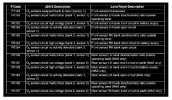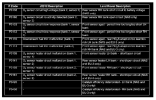AllanWorms
Well-Known Member
Thanks everyone! Here are some replies/next steps:
My mechanic said he looked visually but doesn't have a smoke machine. I tried making a homemade smoke machine with a cigar and a siphon, but it didn't work
Yes, tried a few tankfuls of premium 98 and still the same issue. (Running E10 94 most of the time, but also "premium" 95.)
Idle control valve: couldn't find a video or guide that covers how to remove and clean it.
Is it as simple as this? (1) disconnect battery, (2) disconnect hoses from ICV, (3) remove it, (4) clean with brake cleaner and wait 1h for it to dry, (5) refit everything and go?
Or should I just buy a new one?
For that first error code, how would I troubleshoot the wiring or ECM? (I've tried 6x different O2 sensors and all end up getting this error.)
Thanks, I'll try a fuel injector cleaner. They've got this in AUS for about £3.
Yeah, under load it seems fine.
Once warmed up and while driving, the OBD2 Car Scanner app reports fuel system status:
- ECU #1: Closed loop, using oxygen sensor feedback to determine fuel mix
- ECU #2: Closed loop, using oxygen sensor feedback to determine fuel mix
While stopped at a traffic light, fuel system status:
- ECU #1: Closed loop, using oxygen sensor feedback to determine fuel mix
- ECU #2: Open loop due to system failure
What is this second ECU?
Just to confirm, is that the vacuum leak smoke test the others are suggesting?
After unplugging the battery and driving around for 40 minutes:
Long term fuel % trim - Bank 1: 17.19 %
Long term fuel % trim - Bank 2: 17.97 %
Yeah, it wobbles sideways at idle! Not hugely but noticeably. Funnily, very occasionally it doesn't, especially when the system is reporting both ECU1 and ECU2 running closed loop. But it lasts only a minute and then it starts wobbling again.
My cheap OBD2 scanner app can't seem to report/show misfiring codes even if I had them. I'll borrow a more advanced tool, but that won't be for a week or so. I wonder if there's an iPhone app (can be paid) that can also show this? Shouldn't everything be the same over OBD2 for all devices?
Thanks, will do! Nobody on Facebook/forums near me has a smoke machine and my DIY one didn't work. But I'll manage!
I can only "ASSume" the reader says ECU1 for bank one and ECU2 for bank 2. That does narrow it down a bit, if the fault is generally on bank 2.
Those Long term trims suggest it's running similarly on both banks, when driving at least.
Vacuum leaks affect idle sooo much more, because the engine side of the butterfly is at high vacuum when the throttle is closed, so the pressure differential sucks air through tiny holes. When driving, the vacuum drops and the air takes the easiest path - generally in through the MAF route and any small leaks make very little difference at this point.
*IF* that wobble is from an ignition or compression misfire at idle, it can cause the out of range O2 reading - if one cylinder isn't firing, it doesn't burn it's share of the oxygen, so there is too much in the exhaust on the bank, and the ECU *thinks* it needs to add more fuel... but it doesn't. And it doesn't matter how much fuel is in there, it can *only* read the O2 level. You can try running it with one spark plug lead unplugged at a time, and see which cylinder doesn't make it run worse - that's probably the misfiring one. It does depend if the misfire causes the wobble, or if the fuelling being altered causes the misfire - it can go either way.
A compression test is always a good place to start though. Always do the basics, before getting too complicated... But I'd have thought your mechanic would have done that as a start, if he's doing all the work? Maybe he's not the best option???
Vacuum leaks are still an option too - anything that gets in without the MAF seeing it, is a leak. Make sure the rocker cover gaskets and the dipstick seal correctly. Also check the PCV valve - the 4.0 V8 has some weird valve thing that ****s itself.
You can try something flammable for vacuum leak searches... but it can be dangerous! Yuo can try water in a mister - you can sometimes see or hear it get sucked in, but it doesn't change the idle much. If you use brake cleaner or ether etc, you run the risk of igniting it, but you can usually hear the idle change.
If you can, try to get a really still, clear audio, video clip up - I'd be keen to hear it running with the wobble, to decide it's its just rough, or if it's a single misfire. You can often hear a constant misfire near the tail pipe too.
We basically need to rule some things out, or find some data to give clues on where to go. But basics should never be overlooked as a start. They're the foundation of a good running engine.

